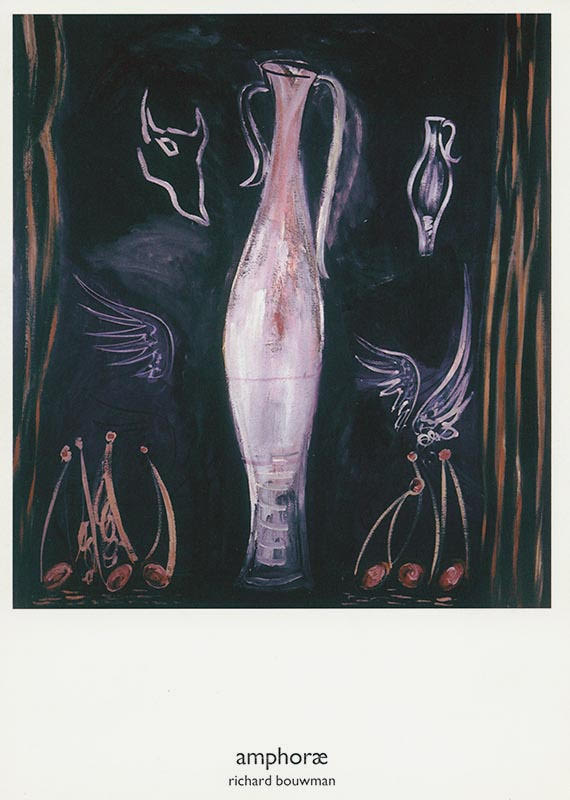Richard Bouwman
kunstinzicht.nlAmphorae, solo exhibition, Foundation Visual Art, Amsterdam
27-03-1992 t/m 02-05-1992

AMPHORAE
The Visual Arts Foundation (SBK) Amsterdam devoted an exhibition to the work of Richard Bouwman (1947), an artist from Rotterdam. The title of the exhibition is Amphorae, because the amphora belongs to the range of signs which is typical of Bouwman’s work. In the drawings and paintings of this exhibition other recurring motives also appear. The amphora is mainly conceived by the artist as the ‘cup of life’ from which spirituality flows. The shape of the vase has been delineated as human, almost feminine; this thought is emphasized by the fleshy pink colour which Bouwman uses for the amphora. At the same time it remains a utensil from which life-bringing water or wine flows, a utensil which –apart from the present or future- encloses the dream or the reality. Among the other symbols are: the wing, which represents the longing for spirituality and refers us to transience; the oblong eight as the sign of infinity; the horn symbolizing manliness and plenty; the snake is foremost a sign of zest for life, renewal and sensuality; and often a diagonal is found on the drawings serving as a dividing line between the two worlds of the secret and the public. Finally, the movement of the wheel underscores the state of action in the work. In some works he uses words to support the image, without presenting any consistency in the use of letters. The words themselves, often written in reverse, seem to indicate a hidden aspect. In the drawings the images overlap. This presupposes that the depiction has depth, but neither in the drawings nor on the paintings this is the case. With its recurring symbols the work evokes a different world which seemingly originates in the spontaneous movement of the painter’s hand. In his use of colour Bouwman is spontaneous as well. The background in most of the paintings of this exhibition is in dark earth colours, the primary colours added on top are toned down, harsh colours are scarce. The outlines are sketchy, the colour is applied unevenly. It is as if he does not yet allow himself to decide about a final shape. Many of the works evoke an indefinable desire. One feels that sensuality is present as a force, however abstract the concept may be used. Bouwman veils a feeling by seeking after it and he plays with us, the audience. As a palpable image there is a vase of almost two meters, executed in terra cotta and painted and tooled in several techniques. The term Amphorae presupposes a reference to Greek Antiquity. In Bouwman’s early work as of 1980 themes from Greek mythology and philosophy are clearly apparent. The term Amphorae presupposes a reference to Greek Antiquity. In Bouwman’s early work as of 1980 themes from Greek mythology and philosophy are clearly apparent. Walter Burkert, one of the highest authorities in the field of ancient Greek religion, states that ‘a myth is a traditional narration with an underlying reference to something that is of collective interest’. Bouwman is not interested in everyday reality, but searches for human values. In his earlier work Greek gods sometimes occur as persons: Dionysos, god of wine, ecstasy and death, appears in a number of works. Gods and heroes are an essential part of the old myths, but in present times, now that the supernatural belongs increasingly less to our day-to-day reality, the myth remains as a well-liked story: a metaphor or a narration to approach the truth of a certain value. For as much as the Greeks differed from us, they also were very similar. Indeed time changes, but man does not. That is why the history of a certain image does not matter really. The image in itself has eternal life. In his more recent work the fascination for Antiquity has been replaced by the figure of Casanova. Bouwman is inspired by what he has read. Initially he expressed in a figurative form what he imagined. He increasingly came to a more abstract representation, in order to illustrate his search for certain values and forms: in this way the representation of a reality existing beyond art is suggested in the painting. To this effect Bouwman partly uses old symbols, as well as some signs of his own, which keep recurring. Yet he does not lapse into pure symbolism or a form of ritual art, the use of his signs rather seems to create an atmosphere. As viewers we are easily drawn into an environment and do not have to think of continued traditions, with a reference to collective patterns of the subconscious. This makes the work accessible. It is always a problem for the viewer how to understand the spiritual in abstract art. Bouwman helps us by choosing an abstracted imagery and – in line with this thought - the soft colours and the sketchy outlines support the atmosphere and the mystery. The artist has wandered on the path of the philosophical and the occult, but he himself indicates the route. A quote of Barnett Newman is revealing in this respect: ‘The European artists guide us into the spiritual world by means of well-known images ‘. Insofar the work of Richard Bouwman possesses some transcendence, for as indicated hereinbefore, the artist gives us the symbols and does not try to make the imperceptible visible in the sensory perception. From the fact that he has chosen classical symbols, ensues that he can make them travel through time, because they are universal archetypes. Thus the Dionysian aspect returns in his recent work, in which he is insprired by Casanova and his 18th-century environment. Poetry, philosophy and myths constitute a valuable source, from which the artist drinks and is subsequently able to express ‘his world’.
Yvonne Twisk
Translation: Hanny Keulers